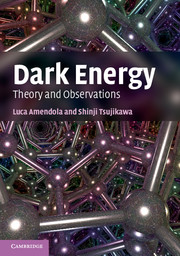Book contents
- Frontmatter
- Contents
- Preface
- List of Frequently used symbols
- 1 Overview
- 2 Expansion history of the Universe
- 3 Correlation function and power spectrum
- 4 Basics of cosmological perturbation theory
- 5 Observational evidence of dark energy
- 6 Cosmological constant
- 7 Dark energy as a modified form of matter I: Quintessence
- 8 Dark energy as a modified form of matter II
- 9 Dark energy as a modification of gravity
- 10 Cosmic acceleration without dark energy
- 11 Dark energy and linear cosmological perturbations
- 12 Non-linear cosmological perturbations
- 13 Statistical methods in cosmology
- 14 Future observational constraints on the nature of dark energy
- 15 Conclusion and outlook
- 16 Answers to the problems
- 17 Mathematical Appendix
- References
- Index
1 - Overview
Published online by Cambridge University Press: 05 March 2013
- Frontmatter
- Contents
- Preface
- List of Frequently used symbols
- 1 Overview
- 2 Expansion history of the Universe
- 3 Correlation function and power spectrum
- 4 Basics of cosmological perturbation theory
- 5 Observational evidence of dark energy
- 6 Cosmological constant
- 7 Dark energy as a modified form of matter I: Quintessence
- 8 Dark energy as a modified form of matter II
- 9 Dark energy as a modification of gravity
- 10 Cosmic acceleration without dark energy
- 11 Dark energy and linear cosmological perturbations
- 12 Non-linear cosmological perturbations
- 13 Statistical methods in cosmology
- 14 Future observational constraints on the nature of dark energy
- 15 Conclusion and outlook
- 16 Answers to the problems
- 17 Mathematical Appendix
- References
- Index
Summary
From the observational data of Supernovae Type Ia (SN Ia) accumulated by the year 1998, Riess et al. [1] in the High-redshift Supernova Search Team and Perlmutter et al. [2] in the Supernova Cosmology Project Team independently reported that the present Universe is accelerating. The source for this late-time cosmic acceleration was dubbed “dark energy.” Despite many years of research (see e.g., the reviews [3, 4, 5, 6, 7]) its origin has not been identified yet. Dark energy is distinguished from ordinary matter species such as baryons and radiation, in the sense that it has a negative pressure. This negative pressure leads to the accelerated expansion of the Universe by counteracting the gravitational force. The SN Ia observations have shown that about 70% of the present energy of the Universe consists of dark energy.
The expression “dark energy” may be somewhat confusing in the sense that a similar expression, “dark matter,” has been used to describe a pressureless matter (a non-relativistic matter) that interacts very weakly with standard matter particles. The existence of dark matter was already pointed out by Zwicky in the 1930s by comparing the dispersion velocities of galaxies in the Coma cluster with the observable starmass. Since darkmatter does not mediate the electromagnetic force, its presence is mainly inferred from gravitational effects on visible matter. Dark matter can cluster by gravitational instability (unlike standard dark energy) so that local structures have been formed in the Universe.
- Type
- Chapter
- Information
- Dark EnergyTheory and Observations, pp. 1 - 6Publisher: Cambridge University PressPrint publication year: 2010



